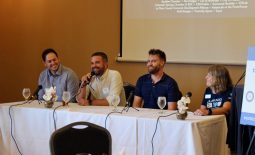The Sky isn’t Falling for Tech Literacy within the Latest Generation
Welcome to Day 2 of the CTA Tech Tour. Day 1 in Colorado Springs was great and now we are headed up the mountains to stop at Frisco and Vail. A new day also means a new theme and today’s theme is the importance of STEM education and tech literacy.
By now, I think we have all been told about the rise of the millennial generation in the workforce. There have been countless articles and blog posts about how to prepare for this new generation entering the workforce. Frankly, the transition from one generation to the next as the majority of the workforce happens every 10 years or so and all the content on millennials entering the workforce has been a bit overblown. We’ve been there, done that.
However, the fact can’t be ignored that somewhere between 2020 and 2025, millennials are going to be the majority of the workforce:
By 2020, nearly half of all U.S. workers will be millennials, according to PricewaterhouseCoopers’ 2011 report, Millennials at Work: Reshaping the Workplace. By 2025, they are expected to represent 75 percent of the global workforce.
What this incoming majority is bringing with them is a flood of people that are going to be extremely tech literate. But wait, if you were to do a simple Google search on “millennial tech literacy,” you are going to find countless articles on how millennials aren’t actually tech literate. They are going to point to millennial scores on the PIAAC test being low. So how can I say millennials are tech literate? Because the “lack of tech literacy / sky is falling” warning has been happening for 70+ years now. We have been saying this has been a problem since WWII and falling behind the rest of the world is imminent:
So why the persistent anxiety that a STEM crisis exists? Michael S. Teitelbaum, a Wertheim Fellow at Harvard Law School and a senior advisor to the Alfred P. Sloan Foundation, has studied the phenomenon, and he says that in the U.S. the anxiety dates back to World War II. Ever since then it has tended to run in cycles that he calls “alarm, boom and bust.” He says the cycle usually starts when “someone or some group sounds the alarm that there is a critical crisis of insufficient numbers of scientists, engineers and mathematicians” and as a result the country “is in jeopardy of either a national security risk or of falling behind economically.” In the 1950s, he notes, Americans worried that the Soviet Union was producing 95,000 scientists and engineers a year while the United States was producing only about 57,000. In the 1980s, it was the perceived Japanese economic juggernaut that was the threat, and now it is China and India.
We are now in another cycle of worry and these cycles generally correlate to when another country makes progress. We look at test scores and the number of STEM degrees students are graduating with each year in this country and freak out because they are lower than everyone else. We should always be trying to improve those numbers, but we need to realize those numbers don’t necessarily indicate what’s actually happening.
Here at ReadyTalk, we have software engineers who don’t have a degree in engineering or computer science. A former software architect that used to work here had a bachelor of arts in music and he was fantastic. I have a bachelor of science in criminal justice and guess what? I’m a software product manager. This kind of professional transition from a non-STEM background into a STEM background is very common in today’s workforce.
Another surprise was the apparent mismatch between earning a STEM degree and having a STEM job. Of the 7.6 million STEM workers counted by the Commerce Department, only 3.3 million possess STEM degrees. Viewed another way, about 15 million U.S. residents hold at least a bachelor’s degree in a STEM discipline, but three-fourths of them—11.4 million—work outside of STEM.
The incoming generation of millennials might have low PIAAC scores, struggle learning your homegrown billing software, or figuring out Excel (don’t we all) but that shouldn’t be an indicator of their tech literacy, because I’m guessing a millennial is helping your organization run your social media campaigns. They are the only ones who know how to use Instagram, Snapchat, Vine, Facebook and Twitter properly. I bet your organization has already had a millennial go “shadow IT” and adopt a tool they were already using to get their job done more effectively. If it hasn’t happened, it will… this is how we welcomed Slack to ReadyTalk. Millennials are going to be entering the workforce and be early adopters of an emerging tech trend months before your organization pays attention. They are in the know and you aren’t.
And let’s remember how this generation is growing up, because that is what makes them tech literate. Remember, this is a generation that doesn’t remember the time before the Internet or smartphones. Remember, this is a generation that learned typing before cursive. Remember, this is a generation that gets calls from family members when they don’t know how to use their computer, tablet or smartphone. Remember, this is a generation that doesn’t know a world where tech didn’t dominate their day to day.


